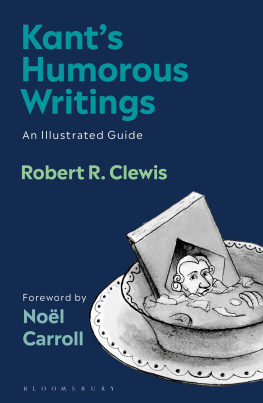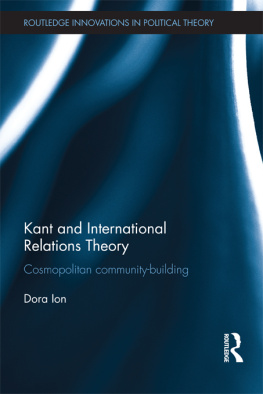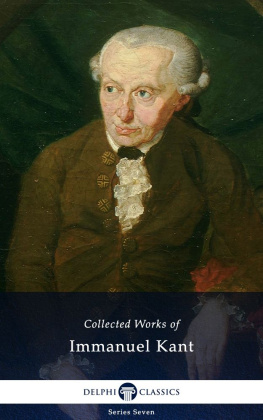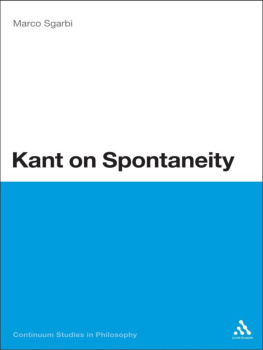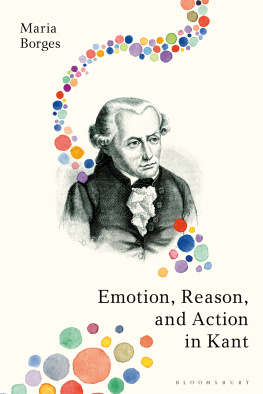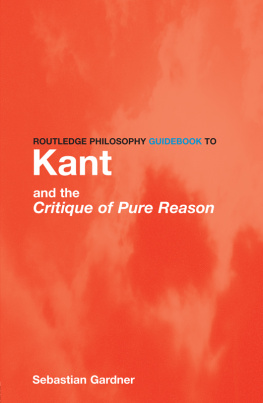
Kants Humorous
Writings
To Richard Martin Clewis, Jr. and
Chester McConnell Thompson
ALSO AVAILABLE FROM BLOOMSBURY
Antigone, Slavoj iek
Venice Saved, Simone Weil
Alienation and Freedom, Frantz Fanon

Contents
The Aesthetic Arts
When I first read one of Kants major works, Critique of the Power of Judgment (1790), I was surprised to find that it included his reflections on laughter and humor. What was humor doing here? This was after all a work of Critical philosophy offered by the transcendental philosopher. I was even more surprised to find no fewer than three jokes in that Critique. Later, when studying Kants university lectures on anthropology, I realized that there were many more references to jest and joking. Humor seemed to be important to Kant. Could he have had a sense of humor?
This is certainly not the traditional view of Kant. Nietzsche, a lover of laughter, writes: I should actually risk an order of rank among philosophers depending on the rank of their laughterall the way up to those capable of golden laughter. Nietzsche could have hardly imagined a jovial Kant.
People who knew Kant personally had a different impression. Johann Gottfried Herderan important poet-theologian-critic in his own rightattended Kants courses between 1762 and 1764. Decades after his student years, Herder penned this: I have had the good fortune of knowing a philosopher who was my teacher. Talk rich in ideas issued from his lips, joking, humor and wit were at his disposal, and his teaching lectures were the most amusing entertainment. This man whom I name is Immanuel Kant.
Nevertheless, stereotypes of boring old Kant linger on. The philosopher is known for taking daily walks, rigid maxims and rule-following, being Prussian and a hypochondriac to boot. This caricature does not go away easily. A prominent scholar of humor once stated that Kant, despite his remarks on laughter, seems pretty dour. True, Kant did openly talk about his health concerns, but he also loved to tell jokes to friends and students.
Is it possible to imagine a laughing Kant? This collection of Kants humorous writings might help.
This book is not a joke. Unlike The Sexual Life of Immanuel Kant, it is not a literary hoax. But the jokes and anecdotes collected in Parts Two and Three amount to no such philosophical work. Kants stories often have an intellectual or moral point, but this does not mean that they make for a serious philosophical oeuvre.
Kants jokes and anecdoteshere translated rather freely so as to improve the set-up and conclusionare classified under several headings. Based on their content, Kants jokes can be classified into the following kinds: jokes of general incongruity (including wordplay), ethnic/sexist jokes or quips, and jokes with a message. In addition, he tells vivid anecdotes to make a philosophical point. While not exactly jokes, these anecdotes display a kind of wit. (This taxonomy is rough-and-ready and should not be insisted on too much, but I hope it is helpful.)
This book is an illustrated guide, and in several senses. First, before I present Kants jokes and anecdotes in Parts Two and Three, I discuss Kants theory of humor in three chapters in Part One. These chapters are meant to guide the reader to a better appreciation of Kants jokes. Second, Kant used many of the jokes and quips to clarify and explain his thoughts about humor. His witticisms help us understandthey illustratewhat Kant found humorous. They reveal what sources and writers helped him formulate his ideas about humor. In addition, I have provided commentary on each of the jokes or anecdotes. Finally, in a third sense of illustrate, this book contains pictorial illustrations. The stories and jokes are accompanied by these images in order to breathe life into the material. To be sure, other books by or about Kant contain pictures or illustrations. Kants third Critique, the Critique of the Power of Judgment, has been published with illustrations and photos. Unlike these, however, the present guide takes thirty jokes or anecdotes told by Kant, and pairs each of them with a specially commissioned illustration wonderfully carried out by Nicholas Ilic.
This collection of humorous writings reveals what Kant considered amusing. To come up with his ideas about humor, he needed some material, and it is interesting to see whom he admired and quoted. We see that Kant took from Samuel Butler, Jonathan Swift, Laurence Sterne, Edward Young, and Voltaire. The sayings and jokes become interesting not merely on their own, but as they contribute to a deeper understanding of Kant as a writer and philosopher of humor and as a lecturer at the Albertina University of Knigsberg. (After the Second World War, his city Knigsberg, East Prussia, became Kaliningrad, Russia. Today its a Russian exclave between Poland and Lithuania, not far from the Baltic Sea.)
This book is not intended to be an introduction to Kants philosophy in generaleven if I am happy if the reader learns something about freedom, society, or dinner parties. It is not a textbook on the philosophy of humor, and it doesnt tell you how to be funny. Nor is it a comprehensive survey of theories of humor. I mention some theories, old and new, but my discussion does not amount to a comprehensive survey. Rather, this guide is intended for both students and scholars of Kant, eighteenth-century aesthetics, and/or the philosophy of humor, and, more broadly, the interested public. I realize that this is quite an array of audiences, but I hope each reader will find something of interest.
And while I quote extensively from writings and lectures deriving from various periods and recognize that Kants ideas developed over decades, I should point out that my main concern is not to examine for its own sake the development of Kants ideas about humor, wit, or prudence in joking.
Long ago, Lives of Eminent Philosophers by Diogenes Laertius reported anecdotes and sayings associated with various philosophers of western antiquity and also summarized their teachings and biographies. Not all of Kants jokes are amusing, but my aim is not to lampoon him.
Before concluding, I should offer a quick summary of Kants thoughts on humor, especially if the reader wishes to skip my three chapters and jump straight to the jokes. We find something comically amusing, Kant thinks, when we enjoy an incongruity or mismatch between the way things are and the way we expect them to be. His view is not that we are comically amused by all incongruities. Instead, the claim is that when we are comically amused, it is (typically) because we are responding to some perceived incongruity that is enjoyed in itself, that is, without any discomfort or real concern about what we hear or perceive. (In other words, we take the joke as just a joke.) Furthermore, Kant recognizes both the physical and the intellectual elements in humor. Kant thinks that laughter at a joke releases the tension that was built up as we created expectations about what we were hearing or reading. This physical release is agreeable. Laughing at humor involves a workout for both body and mind. When the mind playfully considers the content of the joke or gag (the humor), the body responds with the pleasurable physical release. Since his account of humor refers to a play with thoughts and a play with aesthetic ideas, humor could potentially have an important role in his philosophical system, perhaps even more than he realized. Finally, there is an important ethical and socio-anthropological dimension to humor. Humor can bring us together, and Kant thinks that there is a place for wholesome, amicable teasing. Joshing and ribbing need not always be cruel or inappropriate. It is okay sometimes to laugh at othersa comic or even our friendsespecially if they are in a position to tease us back. Humor offers an important way for us to have fun together, to laugh
Next page
